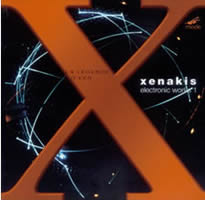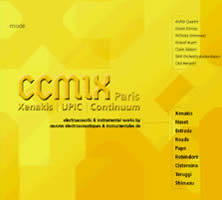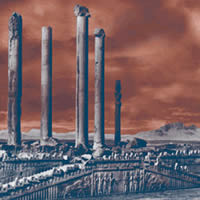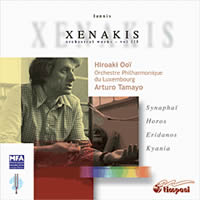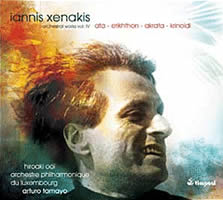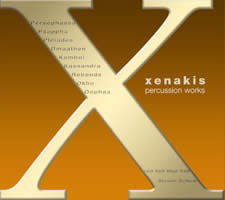New and Essential Xenakis, Part 2
|
Grant Chu Covell [December 2006.] In the extra interview on mode’s La Légende d’Eer DVD, Xenakis states that instrumental and electroacoustic composition pose different problems, and woe betide the composer who attempts to combine them. It’s evident that he and interviewer Harry Halbreich were sniping at Boulez, though presumably Xenakis had misgivings about his own Analogique A + B (1958-59) and Kraanerg (1968-69). In Part I, I suggested that the percussion works can offer easy access into Xenakis’ complex idiom. The altogether differently constructed electroacoustic music can provide another entry point, particularly to those listeners already acclimated to musique concrète and electronics. Be forewarned, however: Xenakis’ tape pieces are strong, assaultive stuff.
“Electronic Works I.” Iannis XENAKIS: La Légende d’Eer (1977-78; stereo mix from orig. 7-track tapes by G. Pape, 2004). mode 148 (http://www.moderecords.com/). Edition Iannis Xenakis Volume 5. CD and DVD versions; DVD contains a film by Bruno Rastoin and a conversation (in English) between Harry Halbreich and Xenakis. “CCMIX: New Electroacoustic Music from Paris.” Iannis XENAKIS: Mycenae Alpha (1978), Prototype de Cluny (1972); Brigitte ROBINDORÉ: L’Autel de la Perte et de la Transformation (1993), Comme Etrangers et Voyageurs sur la Terre (1994); Jean-Claude RISSET: Saxatile (1992); Nicola CISTERNINO: Xöömij (1997); Julio ESTRADA: eua-on (1980), eua-on-ome (1995); Daniel TERUGGI: Gestes de l’écrit (1994); Takehito SHIMAZU: Illusions in Desolate Fields (1994); Curtis ROADS: Purity (1994), Sonal Atoms (1998); Gérard PAPE: Le Fleuve du Désir III (1994). Roland Auzet, Claire Talibart (perc); Daniel Kientzy (sax); Nicholas Isherwood (bass); SWF Orchestra of Baden-Baden, Olaf Henzold (cond.); Kazuko Takada (san-gen, voice); The Arditti Quartet. mode 98/99 (http://www.moderecords.com/). 2CDs. Generally, Xenakis’ mature electronic works progress slowly, often sustaining a claustrophobic din for their duration. Beginning with the 21:36 Bohor (1962), Xenakis explores a few sounds, repeating and layering them, often at top volume. Gérard Pape’s La Légende d’Eer remix lasts 47:04 (1:04 longer than the version on Auvidis Montaigne MO 782058) and restores nearly 150 seconds from the original masters of previously unreleased material. Opening with sheaves of high pitches, the frequency range gradually descends to the middle register before retreating upwards at the end. We hear what sounds like an African thumb piano (which the score identifies as a guimbarde, or “Jew’s harp”), a whiny buzzing akin to an insect or pressurized gas escaping from a container, and a resonant squeak alternately metallic and avian, all of which is slowly changed and blended. Xenakis enthusiasts will catch echoes of the contemporaneous orchestral Jonchaies (1977). Both hide rapidly transforming video-game-like pitch sequences and conclude with high-pitched chirps. The DVD contains a film by Bruno Rastoin intended to accompany Xenakis’ score. Actually it’s a slide presentation documenting the work’s venue, “Le Diatope,” Xenakis’ huge, intersecting red-clothed parabolas which stood outside Centre Pompidou in Paris for several months in 1978. Rastoin’s phasing stills indicate the numerous lights, mirrors and colored lasers, but lacking motion, there’s no sense of scale, space, or how the light show progressed. Rastoin helped in the diatope’s creation and was perhaps too closely involved with the spectacle to provide a simple introduction. As an aural event, La Légende d’Eer might be better appreciated. The screen, which remains disarmingly dark during the opening credits, sensitizes the viewer to the gradually changing sounds. The Halbreich-Xenakis conversation affords an intimate look at the composer discussing his music and experiences. Xenakis wanders from topic to topic, barely answering Halbreich’s lightly inflated questions. Both believe that total serialism was a disaster. No news there. When Halbreich confesses he doesn’t appreciate Xenakis’ ST series, the composer retorts that he’s not fond of it either. Such gems offset the video’s amateurish quality, e.g., the persistence of MAR. 6.95 in the lower right-hand corner. I wonder about Xenakis’ health around that time: He seemed easily distracted. Mode has released more Xenakis electroacoustic works in a generous double set which throws light on the activities of the Center for the Composition of Music Iannis Xenakis (CCMIX, http://www.ccmix.com/), formerly Les Ateliers UPIC, which renamed itself in 2000 to commemorate its founder. CCMIX’s big toy is an electronic drawing board — the UPIC — which allows composers graphically to design electroacoustic music. The UPIC’s first product, Xenakis’ Mycenae Alpha, shimmers and rasps, a sonic drill working at impregnable metal. The earlier, non-UPIC Prototype de Cluny is less belligerent than either Mycenae Alpha or La Légende d’Eer. Built upon a subaqueous base, possibly something slowed down considerably, lightly tinkling chimes mingle with hoarse squeakings, suggesting materials later to appear in La Légende d’Eer. Robindoré built the UPIC-only L’Autel de la Perte et de la Transformation from small sound samples, sometimes called grains. I thought speech was the piece’s source, having created something similar ages ago, but the composer credits flowing water and wind passing through leaves. Comme Etrangers et Voyageurs sur la Terre adds two percussionists over insidious electronics. Risset’s UPIC part contrasts saxophone with a fluid, lifelike tapestry. Cisternino’s Xöömij matches Isherwood’s uncouth, booming bass voice with similarly coarse sounds. Estrada’s pair, eua-on and eua-on-ome, is especially exciting. The later composition (“ome” is Aztec for “two”) recasts the electroacoustic work for orchestra and caps it with an extended coda. Both share the blunt aggression and densely moving masses common to Xenakis. While it’s easy to hear that the works relate, close inspection merely confounds. The years leading up to 1994 must have been especially busy at CCMIX. In addition to Robindoré’s Comme Etrangers completed that year, we also have Teruggi’s magical Gestes de l’écrit, which strives to break the mold with its near-concrète materials, Shimazu’s exploration of voice, san-gen and UPIC, Roads’ Purity and Pape’s Le Fleuve du Désir III for string quartet and UPIC. It’s rather marvelous to observe how the works for instruments and UPIC differ: Shimazu creates an antagonizing atmosphere while Pape’s electronics compete with the quartet, creating distorting mirrors. Roads’ two short pieces don’t credit UPIC, though he apparently used the studio during their creation.
“Iannis Xenakis: Persepolis + Remixes Edition I.” Iannis XENAKIS: Persepolis (1971). Includes nine remixes by Otomo Yoshihide, Ryoji Ikeda, Zbigniew Karkowski, Antimatter, Construction Kit, Francisco López, Laminar, Merzbow and Ulf Langheinrich. Asphodel ASP 2005 (http://www.asphodel.com/). 2CDs. Distributed in the US by Forced Exposure (http://www.forcedexposure.com/). Iannis XENAKIS: ST/48 (ST/48-1.240162) (1959-62); Polytope de Montréal (1967); Nomos Gamma (1967-68); Terretektorh (1965-66); Syrmos (1959); Achorripsis (1956-57); Persepolis (1971); Polytope de Cluny (1972). Var. orchestras, conductors. Edition RZ 1015-16 (http://www.edition-rz.de/). 2CDs. Distributed in the US by Forced Exposure (http://www.forcedexposure.com/). If you can accept La Légende d’Eer with equanimity, you’re certainly ready for Persepolis, first among candidates as the Apocalypse’s sound track. For nearly an hour, dense layers continually chew through predominantly man-made sources: vibrating metal, lamenting panpipes, growling squeaks, soaring planes, string glissandos and tinkling shards recalling the scant Concrète PH (1958). Commissioned by Muhammad Reza Shah for the third annual Shiraz arts festival in Persepolis, Iran, the original presentation involved lights, lasers, children walking through archaeological ruins with lights, and 59 loudspeakers broadcasting the electroacoustic score. This “light and sound” composition must have stunned the audience gathered to celebrate the 2500th anniversary of Iran’s founding by Cyrus the Great. Perhaps someone is fashioning a movie of this too. I am aware of three Persepolis CD releases, each slightly different. The original performance employed eight independent tapes. Presumably whoever mixes the eight tracks into two channels for a CD issue makes decisions regarding panning, balance and volume. At least you won’t have to flip the Philips LP. An o/p 55:06 Fractal Records (FractalOX) quickly achieves the high-decibel maximum (mastering credited to João Rafael). Asphodel’s 2002 release attributes its mix to Daniel Teruggi. At 60:42, it’s the longest of the lot. Daniel Teige claims the shortest offering for Edition RZ which, at 50:49, leaves room for Polytope de Cluny. Asphodel and Fractal permit the incomparable Persepolis to stand alone. Asphodel’s nine remixes reflect the late composer’s ability to populate a bandwagon. Most pale in comparison to the work of the master, primarily because their creators think greater contrasts or volumes are appropriate (Yoshihide, Ikeda, Karkowski), or that spoofing Xenakis means tossing out static bursts (Construction Kit). Antimatter and Langheinrich’s contributions are reasonably subtle, considering the raw materials. López’s is a crescendo. Laminar and Merzbow’s items blur together somewhat, but their departures from Persepolis are welcome, though Merzbow tends towards abrasion. I would rather listen to the original. These brews capture noise well enough but lack Xenakis’ flesh-and-blood terror. As a good thing, none approaches the master’s duration. There has not yet been a “Remixes Edition II.” Except for the 2003 Persepolis mixing, Edition RZ’s two-disc set packages venerable Xenakis ensemble performances. It is both heartening and surprising that none of these large orchestral pieces has yet appeared within Timpani’s series. ST/48 reflects other raucous mid-century works. The cumbersome title indicates a computer-generated stochastic composition for 48 players, that it’s the 1st piece for that size, and that the computer generated its data on the 24th day of the 1st month in 1962. (I wonder if Cage knew about Xenakis’ way with titles when he wrote his number pieces.) Considering that the Polytope de Montréal was originally a complicated light show accompanied by four orchestras, its 6:37 score is surprisingly short. The ORTF’s Ensemble Ars Nova’s different orchestras are clearly discernable. Crunching cello gestures and piercing piccolos permit hearing this as a forerunner to the purely electroacoustic Polytope de Cluny and La Légende d’Eer. Nomos Gamma scatters its 96 players throughout the performance space. The textures swoop through angry winds, clattering col legno and low brass epithets. Persistently hammered drums remind the listener of frantically dribbled basketballs. Terretektorh also casts its musicians (88) around the audience. Where Nomos Gamma seemed random, Terretektorh appears to adhere to a single line with changing colors. Clacking rattles and whirring slide whistles intrude bizarrely. Xenakis seems to be searching for a quality more readily accomplished in the electroacoustic domain. Strings from Ensemble Ars Nova vigorously execute Syrmos’ wild party-favor collection in a manner similar to that of their later Ensemble Resonanze colleagues on mode 152. Achorripsis returns to a late-’50s, splattery canvas, here with vividly captured pizzicatos and an insistent recurring xylophone note. If the listener skips over the oppressive Persepolis, it’s possible to appreciate the 1971 Polytope de Cluny as a conclusion to the orchestras’ spatial distribution.
“Orchestral Works, Volume 3.” Iannis XENAKIS: Synaphaï (1969); Horos (1986); Eridanos (1972); Kyania (1990). Hiroaki Ooï (pno), Orchestre Philharmonique du Luxembourg, Arturo Tamayo (cond.). Timpani 1C1068 (http://www.timpani-records.com/). Distributed in the US by Qualiton (http://www.qualiton.com/). “Orchestral Works, Volume 4.” Iannis XENAKIS: Erikhthon (1974); Ata (1987); Akrata (1965); Krinoïdi (1991). Hiroaki Ooï (pno), Orchestre Philharmonique du Luxembourg, Arturo Tamayo (cond.). Timpani 1C1084 (http://www.timpani-records.com/). Distributed in the US by Qualiton (http://www.qualiton.com/). I considered not discussing the 3rd and 4th installments in Timpani’s ongoing Xenakis “Orchestral Works” series. Not that these discs are bad or inessential. It’s just that if you’re not a Xenakis fan, nothing I’m reporting on here is likely to change your mind. The rest of us can’t wait for Timpani’s next volumes. This music requires precision and dedication and Tamayo and the ambitious Orchestre Philharmonique du Luxembourg are equal to the challenge. These two discs add a soloist, the thousand-fingered Hiroaki Ooï, whose repertoire includes Xenakis’ keyboard works (including the organ and harpsichord compositions), the Boulez sonatas, Stockhausen’s Klavierstücke and similar fare. What must Ooï do for relaxation? Hammer nails with his fists? Haul boulders with his teeth? I ask only because the pianist so casually traverses two of Xenakis’ three piano-plus-orchestra works. In Synaphaï, the piano drowns under a sea of sliding strings, multiphonic winds and growling brass. The orchestra is in control despite several solo moments and a celebrated piano passage which requires ten staves for its notation. The closing pages culminate in several volleys between soloist and orchestra; after the last, drums pursue the pianist, and then the piece ends. Erikhthon is a brutal concerto, from the composer’s arborescent phase: notes spreading out like the branches of a tree. At several spots, a microtonal orchestra makes the piano appear out of tune. The predominantly glissando strings create a shearing sensation. The work crests and builds until it abruptly stops. Kyania and Horos share material. In Horos giant lumbering blocks reprise Jonchaies’ pelog scale. Despite the energized Luxembourg orchestra, the mood is despondent. At over 20 minutes, Kyania is longer than most Xenakis orchestral works — a dense, elongated composition, with odd rhythmic fauna filling in the cracks. Somewhat pointillistic, abrupt choir changes and massed instruments huddle like insect swarms. Eridanos incorporates changes in dynamic to a greater degree than most Xenakis works (some pieces are ff throughout, rarely changing volume). With its colorful pizzicatos and shading winds, one is reminded of Ravel and Debussy. Ata hurls ribbons of dense clusters through the orchestra, a ham-fisted organist’s tantrum, eventually resolving into a two-chord duel before storming off. Thick modal wind chords recall Andriessen’s De Staat. A descending glissando towards the end suggests air escaping from a balloon. For merely 16 winds, Akrata alternates silence, overlapping long notes and wide nets of stuttering pitches, all wonderfully resonant and spatial. Gentler than Ata, Krinoïdi’s orchestral choirs sway in clusters.
Iannis XENAKIS: Synaphaï (1969); Aroura (1971); Antikhthon (1969). Geoffrey Douglas Madge (pno), New Philharmonia Orchestra, Elgar Howarth (cond.). Explore Records EXP0017 (http://www.explorerecords.com/). Distributed in the US by Koch Distribution (http://www.kochdistribution.com/). While most recent recordings carry a greater dynamic range contributing to a vital potency, the true Xenakis fan will leap for these November 1976 sessions just to hear alternates. Synaphaï’s durations differ greatly: Madge takes 11:52 to Ooï’s 16:26 (Timpani 1C1068). Timpani’s longer Synaphaï luxuriates in the multifaceted textures. Explore’s reissue doesn’t actually feel faster. It’s more a case of a single, immolating burst. Understandably, Xenakis’ effects were fresh in the mid-’70s, and they’re realized here with a certain recklessness. I wonder if Howarth proceeds briskly to get it over with, or if Tamayo takes his time in order to make it more playable. Madge’s exposed cadenza-like passages (starting around 7:18) are undoubtedly speedier and fiercer than Ooï’s (starting around 9:40), who, by comparison, is surprisingly tender, even across wide swaths of repeated notes. Aroura is merely a half-minute longer here than on mode 152. The 12 New Philharmonia Strings are as energized as today’s Ensemble Resonanze colleagues, despite a subdued midrange. Antikhthon is forceful and potent, delivered with brutality rather than finesse. As with Edition RZ’s collection of Xenakis orchestral works, it’s good to have these recordings back in circulation.
“Percussion Works.” Iannis XENAKIS: Persephassa (1969); Psappha (1975); Dmaathen (1977); Pléïades (1978); Komboï (1981); Kassandra (1987); Okho (1989); Oophaa (1989); Rebonds (1989). Steven Schick (perc); red fish blue fish: Patti Cudd, Aiyun Huang, Terry Longshore, Brett Reed, David Shively, Vanessa Tomlinson, Gustavo Aguilar, Rob Esler, Ross Karre, Don Nichols, Morris Palter, Lisa Tolentino, Ivan Manzanilla, Greg Stuart; Jacqueline Leclair (ob); Shannon Wettstein, John Mark Harris (hpschd); Philip Larson (voice). mode 171/73 (http://www.moderecords.com/). Edition Iannis Xenakis Volume 7. Mode’s freshest Xenakis volume collects percussion solos, ensembles and pairings with other instruments. (Percussion ensembles with chorus or soloists, and orchestral works with prominent percussion parts, aren’t included.) Programmed chronologically across three discs, these nine will make the Xenakis fan salivate, though none is a premiere recording. Rebonds, Persephassa, Psappha and Okho have in fact been released on mode before. The duos Dmaathen and Kassandra, for percussion with oboe and voice respectively, stand out, and the sextets Persephassa and Pléïades deliver mightily. Had Xenakis written only Persephassa, percussionists would still revere him in the way that Varèse’s Ionization occupies a special place. Written for Les Percussions de Strasbourg and premiered in Persepolis (two years before the light and sound spectacle Persepolis), the sextet contains several passages which demand each percussionist play at a different tempo (achievable with conductors or click tracks). Xenakis’ design requires the six musicians to encircle the audience so that the distinctly paced patterns whirl about in canon. Red fish blue fish under Schick’s direction delivers a strong performance on well-chosen instruments, improving substantially over mode’s prior release (Juan Pablo Izquierdo leads members of the Carnegie Mellon Philharmonic on mode 58). The “simantra métalliques” (resonant metal bars similar to liturgical Greek instruments) are appropriately bright, and the drums deliver gut-punching wallops. With its evenly matched tremolos building to an awesome din, the final revolving acceleration (starting at 21:40) progresses smoothly. Schick’s notes admit that multi-tracking was used in these last pages to achieve what is essentially impossible for six players. The strident four-movement Pléïades is an easy favorite — I used it years ago to counterattack a noisy neighbor. Where chaotic Persephassa explored asynchronicity and randomness, the martial Pléïades’ four movements emphasize regularity and order. The first movement, “Mélanges,” presents the work’s entire 40-plus-minutes gamut. Its initial barrage introduces a new instrument, logically named sixxen for Les Percussions de Strasbourg’s six players plus Xenakis. Each player stands before an arrangement of 19 metal plates tuned to a scale of third and quarter tones, arrayed to mimic the standard keyboard layout despite the impossibility of unisons and standard intervals. With a bright attack and minimal resonance, the microtonal sixxen sound alternately regal and raucous (red fish blue fish player Brett Reed built these sixxen). “Métaux” is for sixxen alone. “Claviers” sticks to standard pitched percussion; its minimalist patterns may seem an odd avenue for Xenakis except that the notes follow Indonesian modes. The mighty “Peaux” for drums provides a satisfyingly cathartic conclusion. Red fish blue fish’s ordering of the central movements, “Claviers” and “Métaux,” deviates inconsequentially from two Les Percussions de Strasbourg recordings, Harmonia Mundi HMC 905185 (rec. 1986) and Denon 81757 3678 2 (rec. ’88). The ADD Harmonia Mundi deserves a place only on Xenakis fanatics’ shelves. (The booklet includes a photo of the sextet and composer grouped around a sixxen.) A properly dynamic recording of Pléïades requires technology that wasn’t at hand, at least for this Jan. ’86 session. The Denon release adds Maki Ishii’s Concertante, Op. 79, for solo marimba (Keiko Abe) and six percussionists. Not to fault Ishii, but nothing sounds good after Pléïades’ thumping “Peaux,” a movement I frequently spin independently or encore after playing all four. The red fish blue fish troupe (one sextet delivers “Mélanges,” another the remainder) play with effortless verve. These invigorating salvos readily surpass the Strasbourg percussionists’ recordings. As with Persephassa, the listener appears to be in the middle of the action. The engrossing Oophaa and Komboï are scored for the unlikely coupling of percussion and harpsichord, in this instance a 1932 Pleyel. Presuming the players have the chops to navigate these essentially brutish conversations, balance is the enemy. As in the large ensemble sets, these kits (Stuart in Oophaa and Huang in Komboï) span a wide and colorful spectrum. Xenakis’ harpsichord writing demands insolence rather than grace, and Harris (Oophaa) and Wettstein (Komboï) oblige. Couperin would weep. Observed through a jilted kaleidoscope, Oophaa explores modes and repeating patterns, whereas Komboï is more dissonant and aggressive, excepting minimalist modal explorations. These duos were written specifically for Sylvio Gualda and Elisabeth Chojnacka, whose hard-to-find recordings will reward the searcher. Their 1990-taped Oophaa lives on ADDA 581224 alongside works by Solal, Miereanu, and — gasp! — Aperghis and Ferrari! Komboï was reissued on a briefly appearing Warner Erato double set (Erato 8573-84254-2), which paired a favorite collection (Boulez and Michael Tabachnik conducting the Ensemble InterContemporain in Phlegra, Jalons, Keren, Nomos Alpha and Thalleïn) alongside a harpsichord-themed disc (Chojnacka, Gualda and the Ensemble Xenakis under Huub Kerstens in Naama, À l’Île de Gorée, Khoaï and Komboï). Chojnacka’s instrument zings aggressively, frequently succumbing to Gualda’s outbursts. In the creepy Kassandra, Xenakis requires the solo voice to alternate between low singing and strident falsetto. On occasion, the singer strums a 20-string psaltery, contributing to a Partch-like aura. Kassandra was written for Gualda and the athletic baritone Spiros Sakkas. Hear them on Montaigne MO 782151 where Kassandra becomes the second movement in the chorus-plus-orchestra Oresteïa (1966). Recorded live in an unflattering acoustic, Sakkas and Gualda’s increasing frenzy hurls the unhappy story along in an unsatisfying and perfunctory 13:47. Setting a new standard, Larson and Schick gambol methodically to close at 20:48, readily exposing the music’s disturbing contours. Larson takes a similarly demanding part in La Déesse Athéna (1992) for voice and 11 musicians on mode 58. With respect to Okho in Part I, I expressed a preference for Trio Le Cercle’s swagger (Montaigne MO 782002). I realize now that they indulged in rather fluid tempos. Here red fish blue fish’s evenness and consistency impress. It’s amusing to consider that this Greco-African drumming piece was commissioned to commemorate the French Revolution, though I suppose one could argue that the trio represents liberté, égalité and fraternité. One of contemporary music’s stranger intersections occurred whenever Feldman and Xenakis met (read this fascinating transcript). As Schick explains, Dmaathen arose over a plate of chicken wings, at which repast Feldman mentioned that oboist Nora Post and percussionist Jan Williams required a new duo. An odd pairing: The oboe’s frequent multiphonic sliding conjures primitivism despite the jazzy vibraphone, an unexpected Xenakis sonority. As in a B-movie snake-charming scene, you can almost see the cobra emerging from the basket. Even for Xenakis, it’s an odd Eastern wink. Schick delivers a delicate Psappha, making this solo showpiece sound easy. His 13:59 take is quite unlike Pedro Carneiro’s resonant 12:40 rendering (Zig Zag Territories ZZT 040901). By contrast, Schick’s molten Rebonds pair (in the customary order, B then A) is crisp and clear, with sharp spatialization in the tempestuously building A. Stepping back to 1994, it was a pleasure to replay “Born to Be Wild,” Schick’s solo release on Newport Classic (NPD 85566), with smart pieces by Lang, Globokar, Wuorinen, Ferneyhough, Rzewski and Rebonds. Over a decade later, it’s as if Schick has reacquainted himself with his first car. He’s a more mature driver now, but he can still make it purr. Back in Part I, I pointed out a recurring gesture in mode 80’s Dikhthas (ca. 12:08) and Palimpsest (ca. 5:27). Well, it reappears here too, around 1:52 in Dmaathen and all over Pléïades (“Mélanges:” ca. 3:59; “Métaux:” ca. 10:18; “Peaux:” opening, ca. 5:50, etc.).
[More Grant Chu Covell]
[Previous Article:
Never Enough String Quartets!]
[Next Article:
Letter from the Provinces: Countdown and Wrap-up]
|
